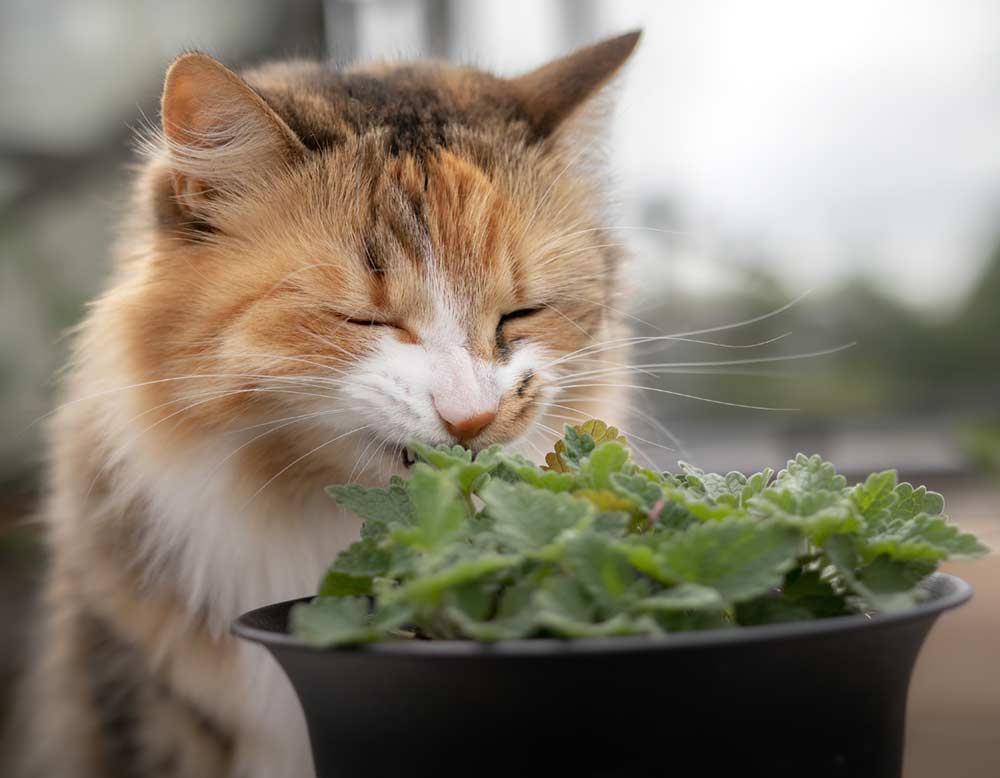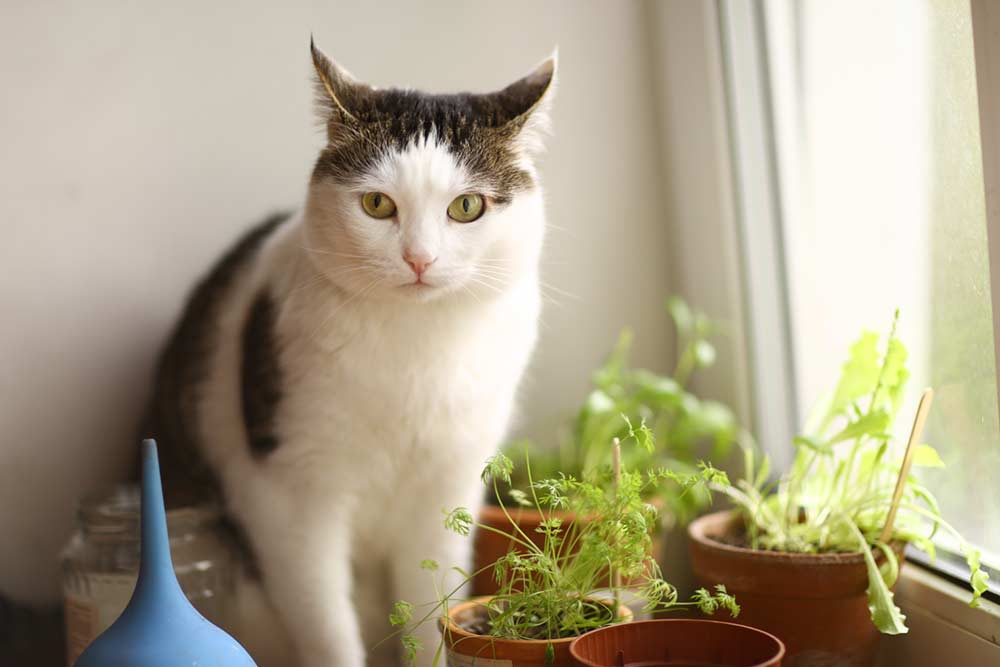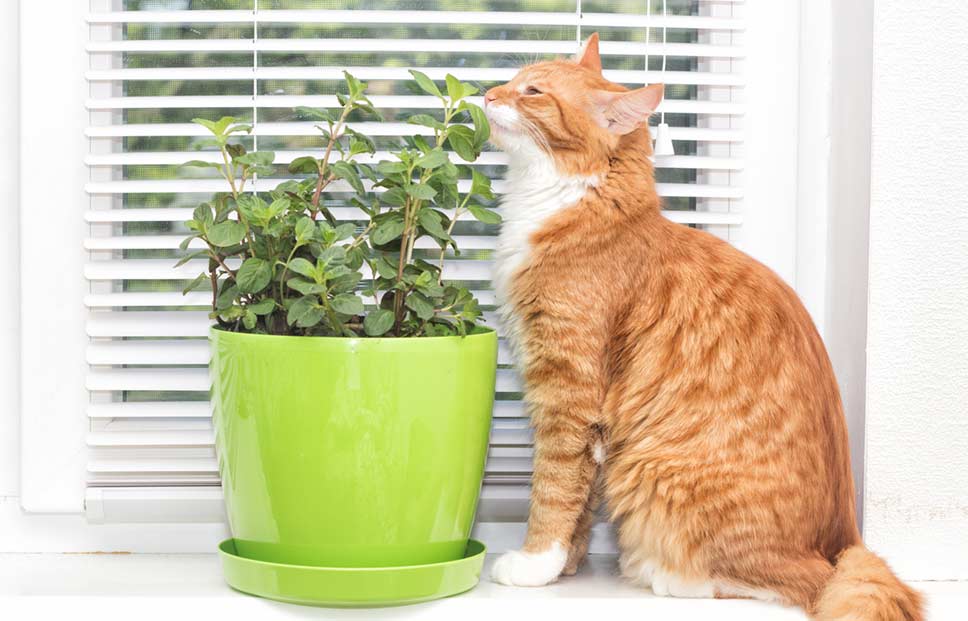What is a mint plant?
Mint is a perennial herb with fragrant leaves and a square stem. A couple of its many uses for humans are as a digestive aid and headache relief. It’s used in recipes from tea to butter. Mint looks a lot like (and can smell like) catnip.
Is the mint plant poisonous / toxic to cats?
Yes, the mint plant is toxic to cats and dogs, according to the ASPCA Pet Poison Control Center (Source) Due to essential oils present in mint, all parts (leaves, flowers, and stems) of the mint plant are toxic to cats.
Toxicity class – how dangerous is it for my cat?
Mints (pennyroyal, peppermint, spearmint, wintergreen, etc.) contain menthol, which makes them highly toxic to cats.
What happens if a cat eats a mint plant?

Different cats react differently to garden mints. Some of the poisoning symptoms to watch for are:
- Diarrhea, cramps, gastrointestinal upset, or heartburn
Watery stools alone can precipitate dehydration. If your cat is vocalizing more than often or is restless, they may be in pain. Vomiting in an attempt to purge the toxins from their body can add to dehydration if the vomiting continues for any length of time.
- Increased heart or respiratory rate
An increased heart or respiratory rate in your cat could be caused by exercise, fear, or excitement. If none of these conditions are present, and especially if you know your cat has ingested a mint plant, this is an indication that something is wrong and you need to contact a vet.
- Lethargy or weakness
You know your cat best. If they are usually up, around, and cheerful then suddenly become cranky or lethargic, this is another clue that something is not right.
If your normally active cat ingests a toxic substance, it can deplete their energy or cause incoordination. If you notice your usually graceful feline stumbling, this could be a sign of toxicity.
- Frenzy or erratic behavior
Since cats may react differently from one another, the opposite of lethargy is another symptom to watch for.
What happens if a cat touches a mint plant?
Brushing up against or smelling a mint plant should not be an issue. The only concern would be if your cat decides it smells so good, they decide to take a nibble. Depending on the cat, one lick might cause them to vomit. If it only happens once, the cat will most likely be fine.
Would my cat actually eat a mint plant if I had it at home?
Some cats are attracted to the mint smell and others are not. If they are not, they would most likely not attempt to take a bite of the plant. Those that are could potentially confuse it with catnip and starts chewing on it.
How much would a cat need to eat to experience serious issues?

Mint poisoning occurs after a cat either eats a large amount of mint or is exposed to the essential oils for an extended period of time.
Would my cat need emergency veterinary help if they ate a mint plant?
If you know for sure that your cat ate a mint plant, or if your cat is exhibiting any of the above symptoms, an immediate call to the vet is necessary. The vet can give you the advice that you need based on your unique circumstances.
The vet may admit your cat to the veterinary hospital for a few days to monitor them and keep them properly hydrated.
Signs you need to see the vet / How can the vet help?
If your cat is showing any signs of poisoning (mint plant or otherwise) you need to see the vet right away. Your vet will examine your cat and may run bloodwork to check your cat’s internal organs. It’s important that you relate any and all information that you have about your cat and the ingested material. If you’re not sure about the type of plant, bring a small sample with you.
Your vet may induce vomiting or administer therapy if it’s needed. Persistent vomiting and diarrhea can lead to dehydration, which requires fluid therapy.
What should I do if my cat eats a mint plant?

If your cat eats a mint plant, your first instinct should be to call your vet with all the facts that you have. Your vet will most likely ask you to bring the cat in. Any type of poisoning should be treated as soon as possible to avoid severe complications.
First-aid kits and supportive care
A first-aid kit is never a bad idea, however, do not attempt to administer first aid unless you have been instructed to do so by your vet. It is never advisable to administer human (or canine) medication to a cat.
Prognosis
The prognosis for mint poisoning is excellent if the cat is treated soon after ingestion. They should be back to normal within a few days.
The bottom line: should I keep my mint plants if they are poisonous? Is there really a risk?
If there is any chance of your cat getting into your mint plants, it is not worth the risk. Although your cat will most likely recover from the toxin, the accompanying illness and the veterinary costs will be stressful.
How do I tell catnip from a mint plant?
Mint and catnip come from the same family of plants, so sometimes it’s difficult to tell them apart. The first thing to look at is the color of the leaves. Mint is usually dark green with a matte finish. Catnip is a bluish-gray color and has a somewhat fuzzy surface.
If you’re still confused, it’s perfectly okay for you to taste them. Mint is stronger, and will leave a lingering cool effect on your tongue due to the menthol. Catnip is weaker and has more of a grassy taste.
If you’re not sure which one you have, it’s best to not offer it to your cat or remove the plant entirely. If all else fails, consult an expert at the garden center or pet store.


